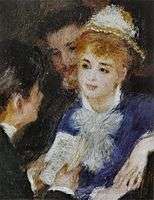Museum of Fine Arts, Reims
The Museum of Fine Arts (Musée des beaux-arts) is a fine arts museum in the French town of Reims.
History
Its collection was founded in 1794 with objects seized during the French Revolution and was first housed in the city's town hall. Throughout the 19th century its collections grew via purchases and bequests, until in 1908 the city of Reims decided to buy a separate building to house it. Their choice fell on the former Saint-Denis Abbey. That building's construction was begun in the 9th century by Fulk on the site of a former cemetery. It had then undergone several uses since the Revolution, as the French Directory's district headquarters, a store for artworks from sold-off churches, in 1814 and 1815 a barracks for Russian occupation troops, and finally in 1822 as a grand seminary. It was abandoned as a seminary in 1906 after the 1905 French law on the Separation of the Churches and the State and the museum moved into it. It was then renovated, with the museum's rooms partly corresponding to the 18th century abbot's palace, rebuilt in the 19th century. The museum was re-opened in its new home on 19 October 1913 by president Raymond Poincaré.
Collections
The collections cover all the main European artistic movements from the 16th to 20th centuries and are shown in chronological and thematic order. Though it also houses sculptures, drawings (including 13 exceptional watercolour portraits on paper by Lucas Cranach the Elder, on rotating show in a special room devoted to them), engravings, furniture and objets d’art, most of the museum's objects are paintings, notably from the Flemish, Dutch and French schools and by historic and modern artists, with the French school being the most strongly represented, notably the 17th century. Artists represented include :
- Flanders, Holland and Germany - Marinus van Reymerswaele, Roelandt Savery, Jacob Jordaens, Bartholomeus van der Helst, Jacob van Loo, Gerard Seghers, David Teniers the Younger, Nicolas Maes, Melchior d'Hondecoeter and Matthias Withoos
- Italy - Giovanni Battista Moroni and Bartolomeo Manfredi.
- France -
- 17th century - Nicolas Poussin, Simon Vouet, the Frères Le Nain (born in the Reims region), Jacques Blanchard, Philippe de Champaigne, Pierre Mignard, Laurent de La Hyre, Sébastien Bourdon, Gaspard Dughet, Charles Le Brun, Jean Jouvenet
- 18th century - François Desportes, François Boucher, Anne Vallayer-Coster, Jacques-Louis David
- 19th century - 27 canvases (second only to the Louvre for this artist) by Camille Corot donated by Henri Vasnier and others, Eugène Delacroix, Richard Parkes Bonington, Théodore Chassériau, Jean-François Millet, Théodore Rousseau, Johan Barthold Jongkind, Gustave Courbet, Honoré Daumier, Eugène Boudin, Claude Monet, Camille Pissarro, Alfred Sisley, Pierre-Auguste Renoir, Pierre Puvis de Chavannes, Henri Fantin-Latour, Eugène Carrière, Paul Gauguin, Émile Bernard, Édouard Vuillard
- 20th century - Pierre Bonnard, Henri Matisse, Raoul Dufy, Albert Marquet, Jean Puy, Louis Marcoussis, Vieira da Silva
Gallery
 Venus at the Forge of Vulcan by the Frères Le Nain, 1641.
Venus at the Forge of Vulcan by the Frères Le Nain, 1641. Conrad Krebs, architect by Lucas Cranach the Elder, 1540
Conrad Krebs, architect by Lucas Cranach the Elder, 1540.jpg) Jeune Alsacienne of Orpheline alsacienne by Rodin
Jeune Alsacienne of Orpheline alsacienne by Rodin La lecture du rôle by Renoir, 1876-1877
La lecture du rôle by Renoir, 1876-1877- Jeune italien assis by Jean-Baptiste-Camille Corot, circa 1825
 Ah ! Le Voilà ! by Henri-Nicolas Van Gorp
Ah ! Le Voilà ! by Henri-Nicolas Van Gorp
External links
| Wikimedia Commons has media related to Musée des Beaux-Arts de Reims. |
Coordinates: 49°15′12″N 4°01′51″E / 49.25333°N 4.03083°E